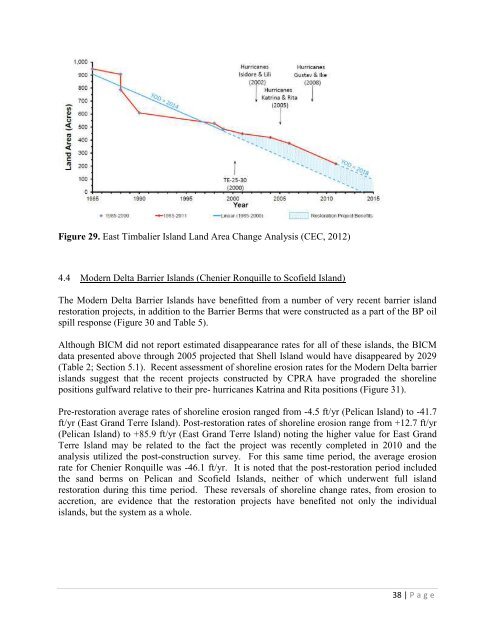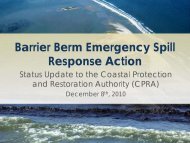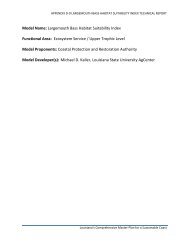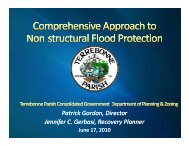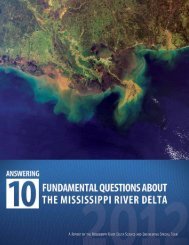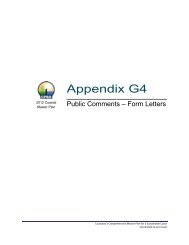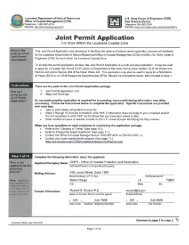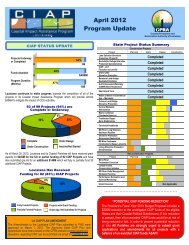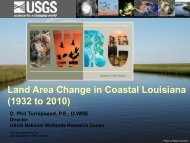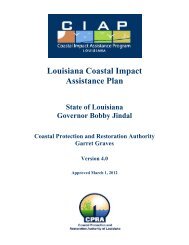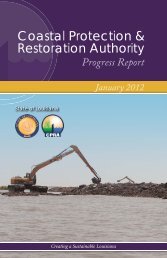barrier island status report - Coastal Protection and Restoration ...
barrier island status report - Coastal Protection and Restoration ...
barrier island status report - Coastal Protection and Restoration ...
Create successful ePaper yourself
Turn your PDF publications into a flip-book with our unique Google optimized e-Paper software.
Figure 29. East Timbalier Isl<strong>and</strong> L<strong>and</strong> Area Change Analysis (CEC, 2012)<br />
4.4 Modern Delta Barrier Isl<strong>and</strong>s (Chenier Ronquille to Scofield Isl<strong>and</strong>)<br />
The Modern Delta Barrier Isl<strong>and</strong>s have benefitted from a number of very recent <strong>barrier</strong> <strong>isl<strong>and</strong></strong><br />
restoration projects, in addition to the Barrier Berms that were constructed as a part of the BP oil<br />
spill response (Figure 30 <strong>and</strong> Table 5).<br />
Although BICM did not <strong>report</strong> estimated disappearance rates for all of these <strong>isl<strong>and</strong></strong>s, the BICM<br />
data presented above through 2005 projected that Shell Isl<strong>and</strong> would have disappeared by 2029<br />
(Table 2; Section 5.1). Recent assessment of shoreline erosion rates for the Modern Delta <strong>barrier</strong><br />
<strong>isl<strong>and</strong></strong>s suggest that the recent projects constructed by CPRA have prograded the shoreline<br />
positions gulfward relative to their pre- hurricanes Katrina <strong>and</strong> Rita positions (Figure 31).<br />
Pre-restoration average rates of shoreline erosion ranged from -4.5 ft/yr (Pelican Isl<strong>and</strong>) to -41.7<br />
ft/yr (East Gr<strong>and</strong> Terre Isl<strong>and</strong>). Post-restoration rates of shoreline erosion range from +12.7 ft/yr<br />
(Pelican Isl<strong>and</strong>) to +85.9 ft/yr (East Gr<strong>and</strong> Terre Isl<strong>and</strong>) noting the higher value for East Gr<strong>and</strong><br />
Terre Isl<strong>and</strong> may be related to the fact the project was recently completed in 2010 <strong>and</strong> the<br />
analysis utilized the post-construction survey. For this same time period, the average erosion<br />
rate for Chenier Ronquille was -46.1 ft/yr. It is noted that the post-restoration period included<br />
the s<strong>and</strong> berms on Pelican <strong>and</strong> Scofield Isl<strong>and</strong>s, neither of which underwent full <strong>isl<strong>and</strong></strong><br />
restoration during this time period. These reversals of shoreline change rates, from erosion to<br />
accretion, are evidence that the restoration projects have benefited not only the individual<br />
<strong>isl<strong>and</strong></strong>s, but the system as a whole.<br />
38 | P a g e


